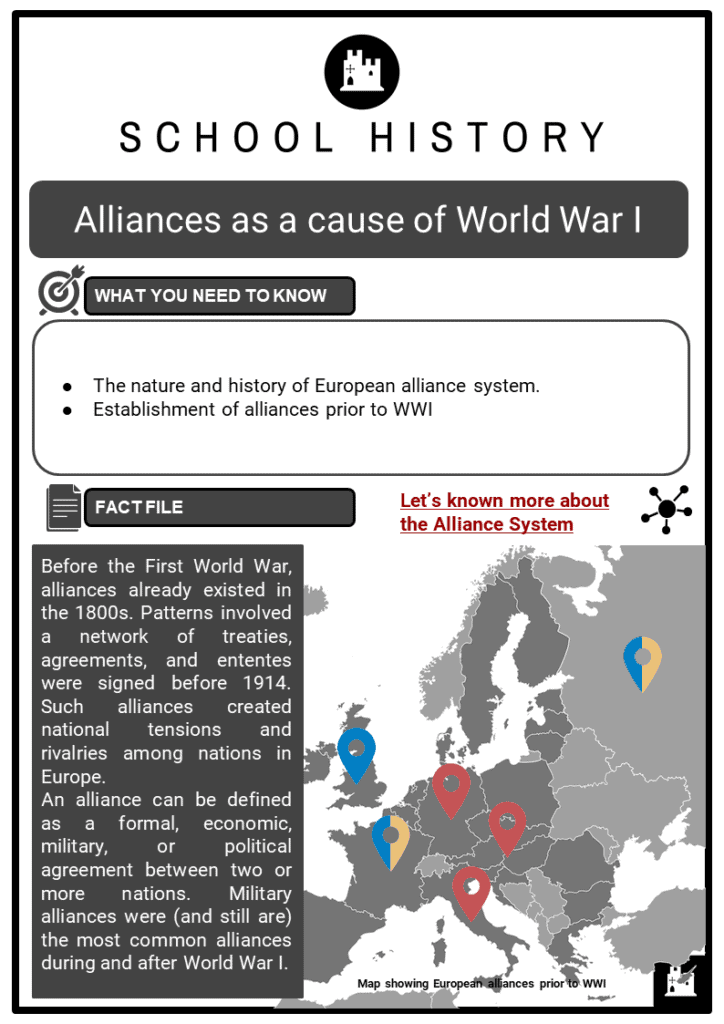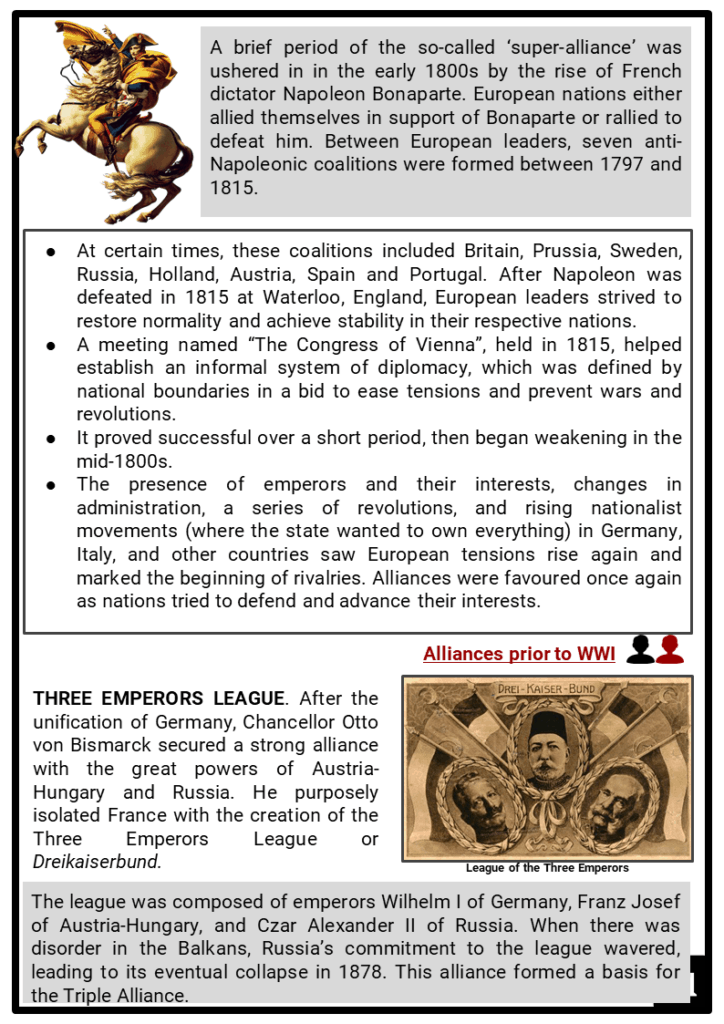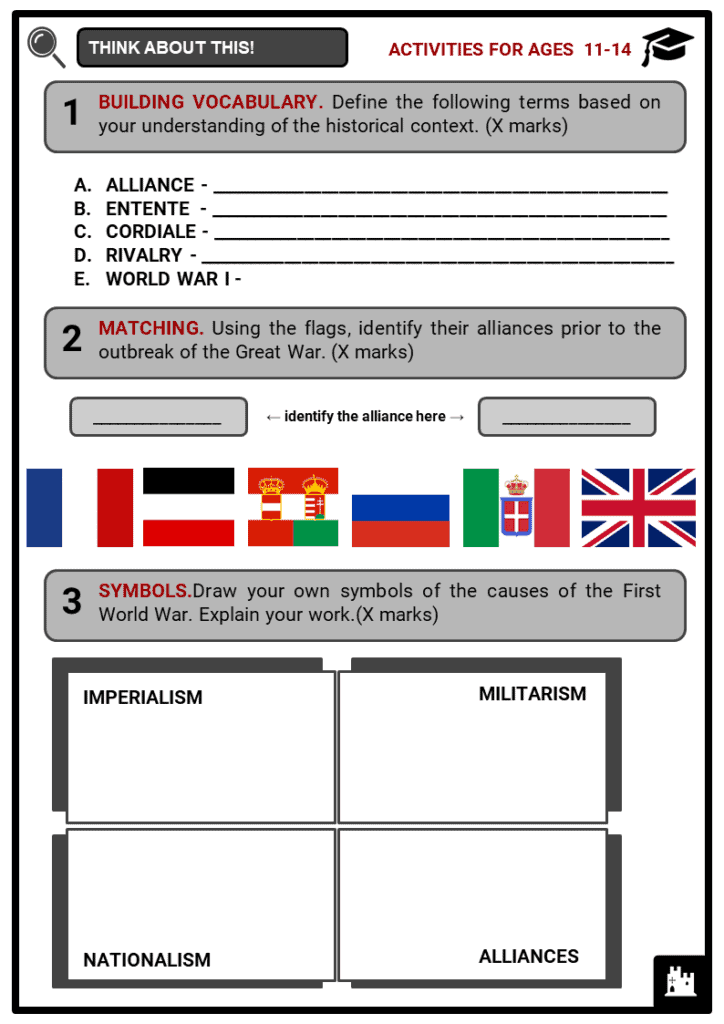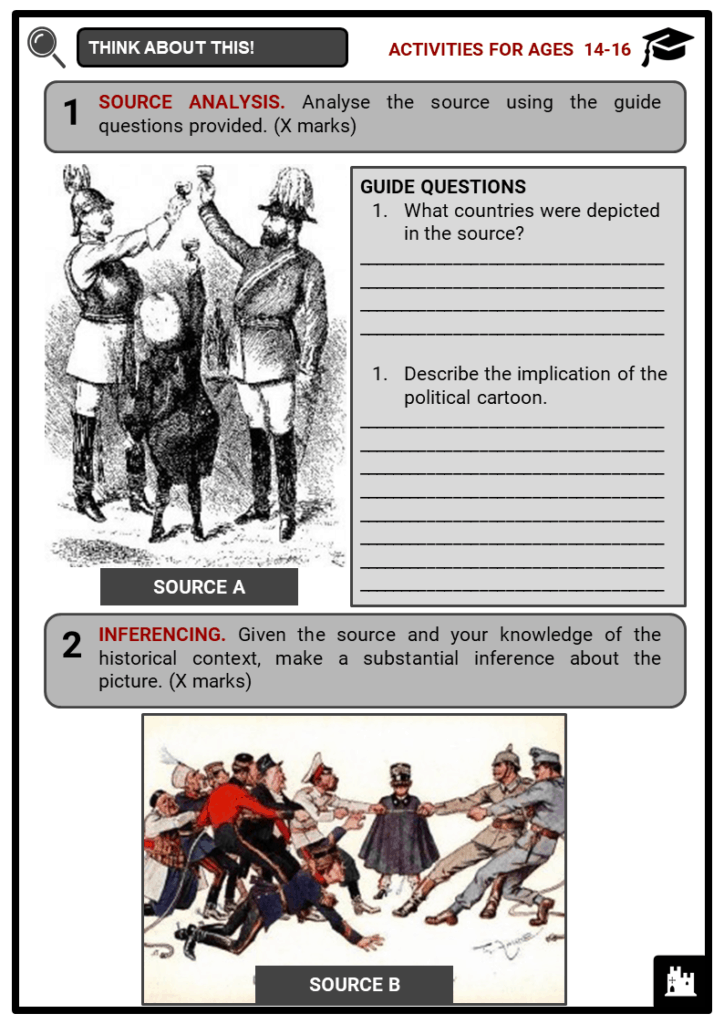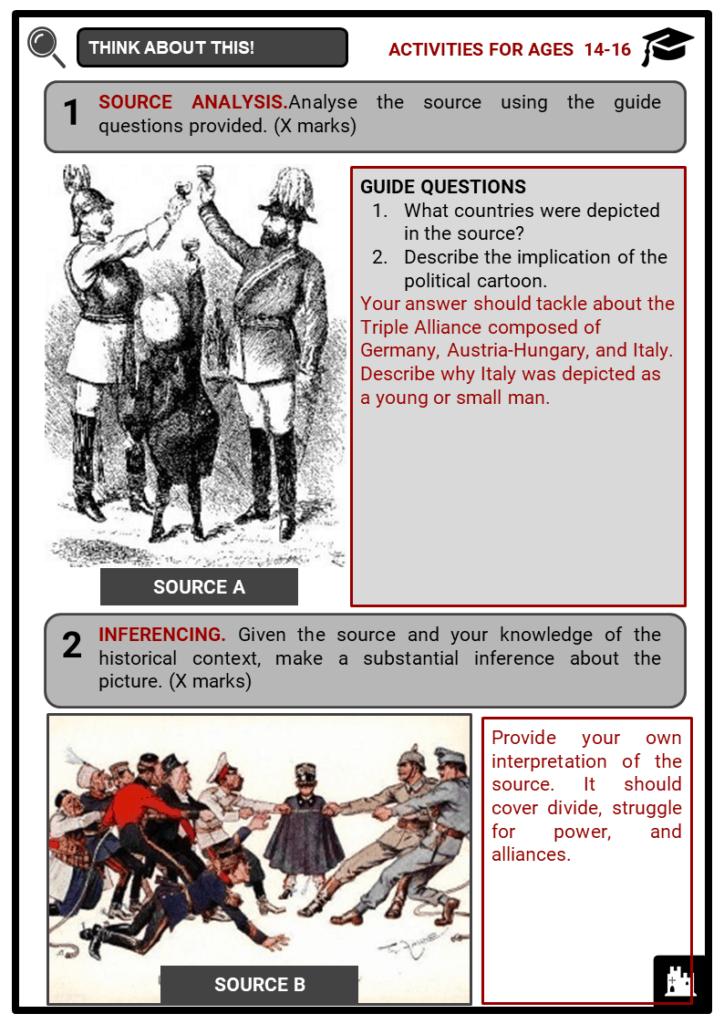Download Alliances as a cause of World War I Worksheets
Do you want to save dozens of hours in time? Get your evenings and weekends back? Be able to teach Alliances as a cause of World War I to your students?
Our worksheet bundle includes a fact file and printable worksheets and student activities. Perfect for both the classroom and homeschooling!
Table of Contents
Add a header to begin generating the table of contents
Summary
- The nature and history of European alliance system.
- Establishment of alliances prior to WWI
Key Facts And Information
Let’s known more about the Alliance System
- Before the First World War, alliances already existed in the 1800s. Patterns involved a network of treaties, agreements, and ententes were signed before 1914. Such alliances created national tensions and rivalries among nations in Europe.
- An alliance can be defined as a formal, economic, military, or political agreement between two or more nations. Military alliances were (and still are) the most common alliances during and after World War I.
- Alliances usually contain pledges that if a war or an act of aggression occurs, one nation will support the other in terms of an army that is mobilising troops, weapons, and relief.
- These terms are usually present in an alliance document. Moreover, alliances can also be economic terms, such as bilateral or multilateral trade agreements, investments, or even loans.
- It was common during the 19th and early 20th centuries for European nations to form, annul, and restructure alliances regularly.
Historical background of alliances
- Alliances were not a new thing in European history. For centuries, there had been ethnic, political, and territorial rivalries in Europe, and they would often, due to paranoia, lead to war.
- An example was France and England, who were ancient rivals, which led to open warfare several times.
- Another example was the relationship between France and Germany. As France and Russia were sworn enemies, this alliance gave some of the European states some protection.
- Alliances prevented larger, stronger states from waging war on the smaller, weaker states. In the 1700s, alliances were both a defence measure and a political instrument. It was not uncommon for kings and princes to form, reform, or restructure alliances in an attempt to benefit their interests.
- Sometimes this was just a move to isolate and starve their rivals. These alliances often did not last as they either collapsed when new leaders took over or were replaced by other alliances.
- A brief period of the so-called ‘super-alliance’ was ushered in in the early 1800s by the rise of French dictator Napoleon Bonaparte. European nations either allied themselves in support of Bonaparte or rallied to defeat him. Between European leaders, seven anti-Napoleonic coalitions were formed between 1797 and 1815.
- At certain times, these coalitions included Britain, Prussia, Sweden, Russia, Holland, Austria, Spain and Portugal. After Napoleon was defeated in 1815 at Waterloo, England, European leaders strived to restore normality and achieve stability in their respective nations.
- A meeting named “The Congress of Vienna”, held in 1815, helped establish an informal system of diplomacy, which was defined by national boundaries in a bid to ease tensions and prevent wars and revolutions.
- It proved successful over a short period, then began weakening in the mid-1800s.
- The presence of emperors and their interests, changes in administration, a series of revolutions, and rising nationalist movements (where the state wanted to own everything) in Germany, Italy, and other countries saw European tensions rise again and marked the beginning of rivalries. Alliances were favoured once again as nations tried to defend and advance their interests.
Alliances prior to WWI
- THREE EMPERORS LEAGUE. After the unification of Germany, Chancellor Otto von Bismarck secured a strong alliance with the great powers of Austria-Hungary and Russia. He purposely isolated France with the creation of the Three Emperors League or Dreikaiserbund.
- The league was composed of emperors Wilhelm I of Germany, Franz Josef of Austria-Hungary, and Czar Alexander II of Russia. When there was disorder in the Balkans, Russia’s commitment to the league wavered, leading to its eventual collapse in 1878. This alliance formed a basis for the Triple Alliance.
- DUAL ALLIANCE. In 1879, a military alliance formed between Germany and Austria-Hungary, stating that should Russia attack either country, they would unite forces and defend the other. It was signed after the collapse of the Three Emperors’ League and when there was unrest in the Balkans.
- German nationalists believed in this treaty as they saw it as a way of achieving their goal of uniting Germany and Austria as one nation.
- TRIPLE ALLIANCE. Formed in 1882, Germany, Austria-Hungary, and Italy made a complex three-way alliance. All of the signatories were willing to provide military support to each other if they were attacked by either of the two powers. Italy was viewed as the weak link in this alliance, being newly formed and having a small army.
- Individual motives of the three:
- GERMANY, being a newly united nation in 1871, sought to capture more territory, particularly part of Austria-Hungary. The way Germany planned to do that was to first help Austria-Hungary seize territory in the Balkans.
- AUSTRIA-HUNGARY was one of the most powerful nations in Europe. As a multinational state, it faced difficulties in consolidating the nations in its territory. To achieve their goal of conquering the Balkan territory, they had to ally with Germany.
- ITALY, despite being a major enemy of Austria-Hungary in the past, Italy recognised it had to join the Triple Alliance to achieve its own goal of setting up colonies in parts of Turkey, Greece, and the Balkan region.
- FRANCO-RUSSIAN ALLIANCE. In response to the Triple Alliance, France and Russia created their own alliance in 1894. The signing of this treaty was unexpected and derailed plans Germany had for mainland Europe. In the process, it also angered Berlin. However, it involved some economic benefits to both nations giving Russia access to French loans and, the French access to Russian minerals, industries and raw materials.
- ENTENTE CORDIALE. In 1904, France and Britain entered a ‘friendly agreement’. It was a number of agreements between Britain and France, and by signing this treaty, the two nations ended a century of hostility. It should be noted that the Entente was not a military alliance, and neither nations pledged military support to the other. It, however, felt like a step forward.
- ANGLO-RUSSIAN ENTENTE. In 1907, an agreement between Britain and Russia was signed as a way to ease tensions and restore good relations between the two nations. For the better part of the 19th century Britain and Russia had gone to war in the Crimea (1853-56).
- They were also on the brink of waging war on each other twice. It resolved the status of colonial possessions in the Middle East and Asia.
- TRIPLE ENTENTE, 1907
- On August 31, 1907, Great Britain, Russia, and France formed the Triple Entente, which then became the Allied Powers in the First World War. ‘Entente’ is French for ‘agreement.’
- This treaty cemented the path that was laid by the Entente Cordiale and the Anglo-Russian Entente. It was a three-way agreement between Britain, France, and Russia, and was not a military alliance. The three Ententes of 1904-07 marked the end of British isolation and neutrality.
- It is worth noting that most of these alliances and ententes were done in secret and were only revealed to the public after signing. Some of the nations in existing alliances conducted negotiations without informing their other alliance partners.
- For instance, the German chancellor Bismarck initiated alliance negotiations with Russia in 1887, without advising their major ally Austria-Hungary.
- Some alliances also entailed ‘secret clauses’ that were not publicly announced for purposes of peace and harmony. These secret clauses only became known to the public after the end of World War I. This secretiveness only served to heighten suspicion and tensions.
- Some historians argued that alliances did not disempower governments or lead to automatic declarations of war and that the authority to declare war was wielded only by the national leaders.
- According to historian Hew Strachan, neither nations, nor their leaders, were willing to fight wholeheartedly for peace.

